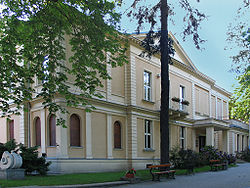State University of Film, Television and Theater Łódź
| State University of Film, Television and Theater Łódź | |
|---|---|
| founding | 1948 |
| Sponsorship | state |
| place | Łódź |
| country | Poland |
| Website | www.filmschool.lodz.pl |
The State University of Film, Television and Theater “Leon Schiller” Łódź ( Państwowa Wyższa Szkoła Filmowa, Telewizyjna i Teatralna im. Leona Schillera w Łodzi , abbreviated: PWSFTviT ) is one of the most important film schools for directors , cameramen and actors in the world. It is located in Łódź in the former industrial area Księży Młyn ( Pfaffendorf ).
The school is subordinate to the Polish Ministry of Art and Culture and indirectly to the Ministry of Education. She is a member of the international film academy association CILECT .
history
Łódź was little destroyed compared to Warsaw . Because of this, cultural life here developed faster after the Second World War . In addition to the settlement of film production in 1948 and the Wyższa Szkoła Aktorska ( Higher Drama School ), the film school was founded on March 8, 1948 under the name Wyższa Szkoła Filmowa ( Higher Film School ). It had two main directions; the training of directors and cameramen . Around 1956, at the time of political unrest, the school developed a curriculum that combined theory and practice. An important contributor to the development was Jerzy Toeplitz , a film historian who became the school's director in 1957. 1958 the drama school and the film school under the name Państwowa Wyższa Szkoła Filmowa i Teatralna im. Leona Schillera (German: State Film and Theater School ) united. The school also attributes an important influence in the spread of jazz in Poland, as cameramen Witold Sobociński and Jerzy Matuszkiewicz were avid jazz musicians and founded the Trad jazz band . In 1958 the student of the Roman Polański school received an award for his film Dwaj ludzie z szafą ( Two men and a cupboard ) at the World Exhibition in Brussels .
Due to political pressure, the director Jerzy Toeplitz left the film school together with other teachers. Toeplitz went to Australia and worked at the film school there. Since the end of the 1970s, the school intensified its international contacts and took part in numerous international film festivals .
Education
There are four areas of directing , cinematography , acting and production management in which about 1,000 students study. Every year, around 12 students from the large number of applicants are accepted into the directing department, around half of whom come from (within and outside of Europe) abroad.
Applicants must pass an entrance exam lasting several days. Applicants come from all over the world. Foreign applicants can take the entrance exam in English. If they are accepted for the course, they must complete a one-year Polish language course before starting their studies. The five-year training covers all theoretical, technical and above all practical aspects of filmmaking. Every year the students realize a large number of so-called “Etueden” (short films), which are assessed at the end of the academic year by an examination committee made up of professors from the university. Teachers generally also work in the practical world and few have a purely academic background. The school has its own professional equipment such as cameras, studios, editing rooms, a sound studio, a theater, etc. It basically functions like a small film studio. The school also has a film archive of student films and a library with the largest collection of film books in Poland.
Personalities
Rectors
- 1952–1957 Roman Ozogowski
- 1957–1968 Jerzy Toeplitz
- 1968–1969 Bolesław Lewicki
- 1969–1972 Jerzy Kotowski
- 1972–1980 Stanisław Kuszewski
- 1980–1982 Roman Wajdowicz
- 1982–1990 Henryk Kluba
- 1990-1996 Wojciech Has
- 1996–2002 Henryk Kluba († 2004)
- 2002–2008 Jerzy Wozniak
- 2008– Robert Gliński
Directors
- Filip Bayon
- Andrzej Barański
- Ryszard Bugajski
- Joseph Cyrus
- Feliks Falk
- Kazimierz Karabasz
- Krzysztof Kieślowski
- Janusz Kijowski
- Andrzej Kondratiuk
- Janusz Kondratiuk
- Kazimierz Kutz
- Witold Leszczyński
- Marcel Łoziński
- Juliusz Machulski
- Lech Majewski
- Wojciech Marczewski
- Janusz Morgenstern , founder of the Polish School
- Andrzej Munk
- Marek Piwowski
- Roman Polanski
- Barbara Sass
- Jerzy Skolimowski
- Piotr Szulkin
- Andrzej Wajda
- Krzysztof Zanussi
- Edward Żebrowski
Cameramen
- Barbara Brylska
- Paweł Edelman
- Adam Holender
- Hoyte van Hoytema
- Sławomir Idziak
- Mieczysław Jahode
- Andrzej Jaroszewicz
- Joanna Jędryka
- Edward Kłosiński
- Zbigniew Lenczewski
- Kazimierz Karabasz
- Michal Majerski
- Zygmunt Malanowicz
- Krzysztof Ptak
- Piotr Lenar
- Pola Raksa
- Zbigniew Rybczyński
- Piotr Sobociński
- Witold Sobociński
- Elżbieta Starostecka
- Witold Stok
- Tomasz value
- Jerzy Wójcik
- Wiesław Zdort
actor
literature
- A retrospective 1948–1988: State University of Film, Television and Theater, Łódź. Ed .: Scotti, Elisabeth. Edited by the West German Short Film Festival in Oberhausen. Published: Oberhausen, Laufen, 1988, ISBN 3-87468-069-X
Web links
- Film school website (Polish, English)
- Lodz in translation Article in NZZ Folio 04/2004
